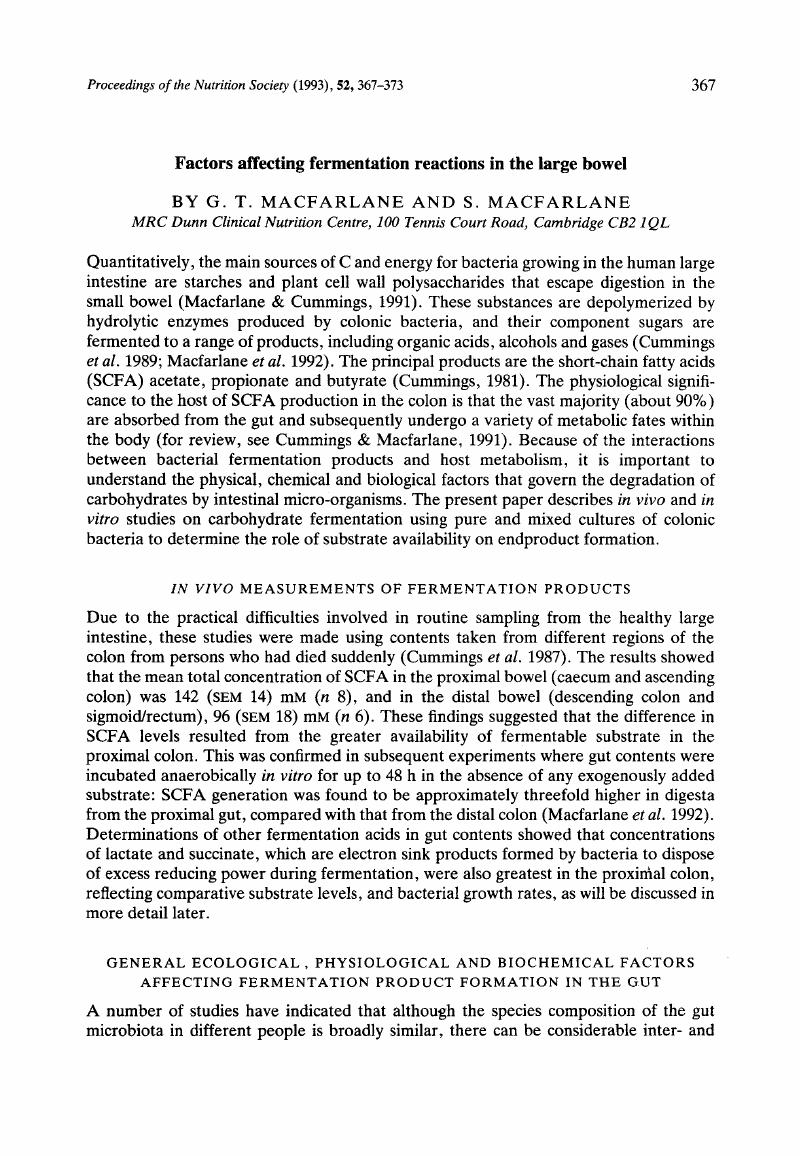Crossref Citations
This article has been cited by the following publications. This list is generated based on data provided by Crossref.
Guillon, Fabienne
Renard, Catherine M G C
Hospers, Jeannette
Thibault, Jean‐Francois
and
Barry, Jean‐Luc
1995.
Characterisation of residual fibres from fermentation of pea and apple fibres by human faecal bacteria.
Journal of the Science of Food and Agriculture,
Vol. 68,
Issue. 4,
p.
521.
Silvester, KR
Englyst, HN
and
Cummings, JH
1995.
Ileal recovery of starch from whole diets containing resistant starch measured in vitro and fermentation of ileal effluent.
The American Journal of Clinical Nutrition,
Vol. 62,
Issue. 2,
p.
403.
Reid, C.‐A.
Hillman, K.
Henderson, C.
and
Glass, H.
1996.
Fermentation of native and processed starches by the porcine caecal anaerobe Clostridium butyricum (NCIMB 7423).
Journal of Applied Bacteriology,
Vol. 80,
Issue. 2,
p.
191.
Alles, MS
Katan, MB
Salemans, JM
Van Laere, KM
Gerichhausen, MJ
Rozendaal, MJ
and
Nagengast, FM
1997.
Bacterial fermentation of fructooligosaccharides and resistant starch in patients with an ileal pouch-anal anastomosis.
The American Journal of Clinical Nutrition,
Vol. 66,
Issue. 5,
p.
1286.
Clements, Kendall D.
1997.
Gastrointestinal Microbiology.
p.
156.
Forsberg, Cecil W.
Cheng, K.-J.
and
White, Bryan A.
1997.
Gastrointestinal Microbiology.
p.
319.
Choat, J. H.
and
Clements, K. D.
1998.
VERTEBRATE HERBIVORES IN MARINE AND TERRESTRIAL ENVIRONMENTS: A Nutritional Ecology Perspective.
Annual Review of Ecology and Systematics,
Vol. 29,
Issue. 1,
p.
375.
Noack, Jutta
Kleessen, Brigitta
Proll, Jürgen
Dongowski, Gerhard
and
Blaut, Michael
1998.
Dietary Guar Gum and Pectin Stimulate Intestinal Microbial Polyamine Synthesis in Rats.
The Journal of Nutrition,
Vol. 128,
Issue. 8,
p.
1385.
Morita, Tatsuya
Kasaoka, Seiichi
Hase, Koji
and
Kiriyama, Shuhachi
1999.
Oligo-L-Methionine and Resistant Protein Promote Cecal Butyrate Production in Rats Fed Resistant Starch and Fructooligosaccharide.
The Journal of Nutrition,
Vol. 129,
Issue. 7,
p.
1333.
Kleessen, Brigitta
1999.
Distribution of viable and non-viable bacteria in the gastrointestinal tract of gnotobiotic and conventional rats.
Microbial Ecology in Health and Disease,
Vol. 11,
Issue. 4,
p.
218.
Alles, Martine S
Hartemink, Ralf
Meyboom, Saskia
Harryvan, Jan L
Van Laere, Katrien MJ
Nagengast, Fokko M
and
Hautvast, Joseph GAJ
1999.
Effect of transgalactooligosaccharides on the composition of the human intestinal microflora and on putative risk markers for colon cancer.
The American Journal of Clinical Nutrition,
Vol. 69,
Issue. 5,
p.
980.
Le Blay, Gwenaëlle
Michel, Catherine
Blottière, Hervé M.
and
Cherbut, Christine
1999.
Enhancement of butyrate production in the rat caecocolonic tract by long-term ingestion of resistant potato starch.
British Journal of Nutrition,
Vol. 82,
Issue. 5,
p.
419.
Dongowski, Gerhard
Lorenz, Angelika
and
Anger, Horst
2000.
Degradation of Pectins with Different Degrees of Esterification by
Bacteroides thetaiotaomicron
Isolated from Human Gut Flora
.
Applied and Environmental Microbiology,
Vol. 66,
Issue. 4,
p.
1321.
Guillon, F.
Champ, M.
and
Thibault, J.F.
2000.
Functional Foods.
p.
315.
Wang, J.F
Jensen, B.B
Jørgensen, H
Li, D.F
and
Lindberg, J.E
2002.
Ileal and total tract digestibility, and protein and fat balance in pigs fed rice with addition of potato starch, sugar beet pulp or wheat bran.
Animal Feed Science and Technology,
Vol. 102,
Issue. 1-4,
p.
125.
Dongowski, Gerhard
Lorenz, Angelika
and
Proll, Jürgen
2002.
The Degree of Methylation Influences the Degradation of Pectin in the Intestinal Tract of Rats and In Vitro.
The Journal of Nutrition,
Vol. 132,
Issue. 7,
p.
1935.
Wang, J.F
Li, D.F
Jensen, B.B
Jakobsen, K
Xing, J.J
Gong, L.M
and
Zhu, Y.H
2003.
Effect of type and level of fibre on gastric microbial activity and short-chain fatty acid concentrations in gestating sows.
Animal Feed Science and Technology,
Vol. 104,
Issue. 1-4,
p.
95.
Wang, J. F.
Zhu, Y. H.
Li, D. F.
Wang, M.
and
Jensen, B. B.
2004.
Effect of type and level of dietary fibre and starch on ileal and faecal microbial activity and short-chain fatty acid concentrations in growing pigs.
Animal Science,
Vol. 78,
Issue. 1,
p.
109.
Wang, J. F.
Zhu, Y. H.
Li, D. F.
Wang, Z.
and
Jensen, B. B.
2004.
In vitro fermentation of various fiber and starch sources by pig fecal inocula1.
Journal of Animal Science,
Vol. 82,
Issue. 9,
p.
2615.
Awati, Ajay
Konstantinov, Sergey R
Williams, Barbara A
Akkermans, Antoon D L
Bosch, Marlou W
Smidt, Hauke
and
Verstegen, Martin W A
2005.
Effect of substrate adaptation on the microbial fermentation and microbial composition of faecal microbiota of weaning piglets studied in vitro.
Journal of the Science of Food and Agriculture,
Vol. 85,
Issue. 10,
p.
1765.





